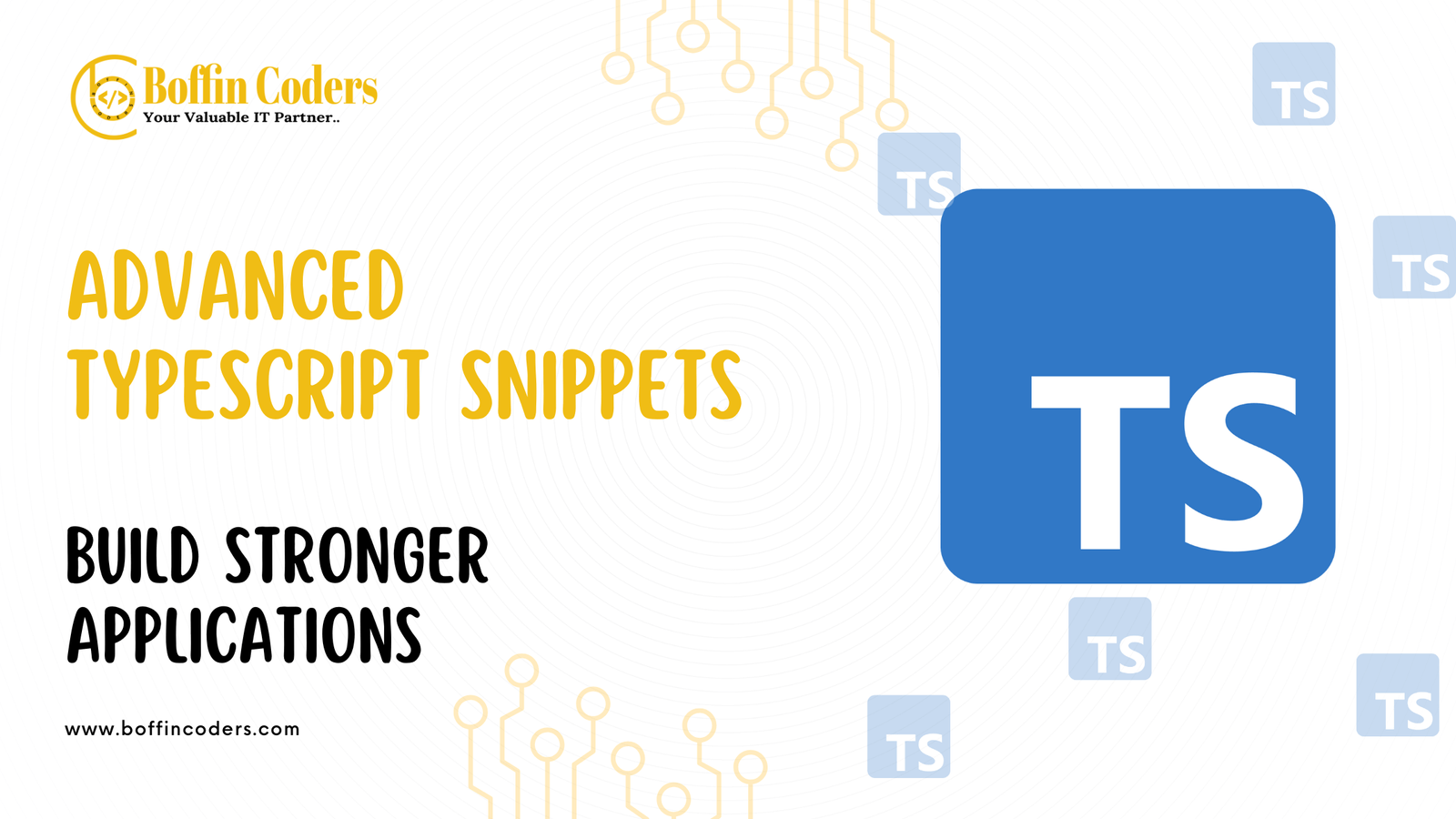TypeScript, with its strong typing system, is a powerful tool that can drastically improve the reliability and maintainability of your code. In this blog, we’ll explore some rare yet incredibly useful TypeScript snippets that can elevate your development process. These examples are particularly valuable for those working on complex applications or who are seeking a partnership with an experienced agency like Boffin Coders.
Let’s Get Started
1. Deep Partial Type
A common requirement when working with complex objects in TypeScript is the ability to update only a part of an object while keeping the rest intact. The DeepPartial<T> type makes all properties in a type optional, even for nested objects.
type DeepPartial<T> = {
[P in keyof T]?: T[P] extends object ? DeepPartial<T[P]> : T[P];
};
Use Case:
Imagine you’re dealing with a complex configuration object that represents user settings. By using DeepPartial<T>, you can easily update a subset of settings without enforcing the entire structure.
Why It Matters:
This approach simplifies updates to large data structures, reducing potential bugs and making the code more maintainable.
Let’s see an example below.
interface Config {
user: {
name: string;
preferences: {
theme: string;
language: string;
};
};
version: string;
}
const partialConfig: DeepPartial<Config> = {
user: {
preferences: {
theme: 'dark'
}
}
};
So, we have this Config interface that’s like a blueprint for some app settings. It includes details about a user and a version number. Now, we want to update or define just parts of it without touching the whole thing.
That’s where DeepPartial<Config> comes in! It lets us only fill in the bits we care about—like just the theme under preferences and leave everything else out. Super handy when you don’t need to deal with the full config!
2. Required Keys
Understanding which properties in a type are required can be critical for maintaining type safety. The RequiredKeys<T> snippet helps extract those keys.
type RequiredKeys<T> = {
[K in keyof T]-?: {} extends Pick<T, K> ? never : K;
}[keyof T];
Use Case:
This type can be especially useful when documenting your API or when you’re validating data structures passed through different layers of your application.
Why It Matters:
Knowing required fields ensures your application’s integrity, preventing runtime errors due to missing data.
Let’s see an example below.
interface User {
id: number;
name?: string;
email: string;
}
type RequiredUserKeys = RequiredKeys<User>; // "id" | "email"
In this User interface where some properties are optional, like name, but others, like id and email, are mandatory. Now, with RequiredKeys<User>, we’re asking, “Hey, which keys in User must always be there?”
And the answer is: “id” and “email“. So, this type RequiredUserKeys is essentially saying, “These are the fields that have to be filled out—no exceptions.” It’s super useful when you need to ensure certain data is always provided.
3. Immutable Type
Immutable data structures prevent accidental changes and ensure that your application’s state remains consistent throughout its lifecycle. Thus you can ensure data integrity with Immutable Types
type Immutable<T> = {
readonly [P in keyof T]: T[P] extends object ? Immutable<T[P]> : T[P];
};
Use Case:
In applications where data integrity is critical (e.g., financial applications, complex UIs), using immutable types can safeguard against unintentional mutations.
Why It Matters:
By enforcing immutability, you can prevent a host of potential bugs that arise from unintended state changes, leading to more predictable and reliable software.
Let’s see an example below.
interface User {
id: number;
profile: {
name: string;
age: number;
};
}
const immutableUser: Immutable<User> = {
id: 1,
profile: {
name: "John",
age: 30
}
};
// This will cause a TypeScript error
// immutableUser.profile.name = "Doe";
You have a User interface with some nested properties. Then, you create an immutableUser using the Immutable<User> type. What this does is make every property in User, including the nested ones, completely unchangeable.
So, when you try to do something like changing immutableUser.profile.name = “Doe”;, TypeScript throws an error because everything in immutableUser is locked down, and no changes are allowed!
4. Union to Intersection
There are scenarios where you need to merge multiple types into one that contains all properties of the union members. UnionToIntersection<U> converts a union type to an intersection type.
type UnionToIntersection<U> = (U extends any ? (k: U) => void : never) extends (k: infer I) => void ? I : never;
Use Case:
When designing APIs or working with complex data types, this snippet can be used to enforce that an object must satisfy multiple types simultaneously.
Why It Matters:
This pattern is extremely useful in API design and other scenarios where complex type compositions are necessary.
Let’s see an example below.
type A = { a: string };
type B = { b: number };
type C = { c: boolean };
type ABC = UnionToIntersection<A | B | C>;
You have three types: A, B, and C. A has a property a, B has a property b, and C has a property c. When you use
So, when you apply UnionToIntersection to A | B | C, the result is type that asks for all keys available in type A, B and C.
You can learn more from this Stackoverflow Link
5. Conditional Type Inference
Conditional types allow for type logic that adapts based on the types provided. This snippet infers types conditionally, based on whether two types are equal.
type IfEquals<X, Y, A = X, B = never> =
(<T>() => T extends X ? 1 : 2) extends
(<T>() => T extends Y ? 1 : 2) ? A : B;
Use Case:
This can be useful in libraries or frameworks where the types may need to adapt based on the inputs, ensuring that functions and components behave as expected.
Why It Matters:
This dynamic adaptability allows you to write more flexible and reusable code, reducing the need for boilerplate type checks and logic.
Let’s see an example below.
type ExampleType = IfEquals<string, string, 'Equal', 'Not Equal'>; // 'Equal'
By integrating these advanced TypeScript snippets into your projects, you can ensure higher quality, maintainability, and reliability in your codebase. And if you’re seeking a development partner who understands the TypeScript and other modern technologies, Boffin Coders is here to help.
The Boffin Coders Advantage
At Boffin Coders, our deep expertise in TypeScript allows us to build robust, scalable, and maintainable applications that meet our clients’ specific needs. Whether you’re looking to develop a complex enterprise solution or a dynamic web application, our team leverages these advanced TypeScript techniques to deliver top-notch software.
Partner with Us:
If you’re looking for a reliable partner to enhance your development process, consider collaborating with Boffin Coders. We specialize in cutting-edge technologies and provide tailored solutions that align with your business goals. Whether you need to hire mobile app developers or leverage our expertise in other areas, we’re here to help. Let’s build something extraordinary together.




